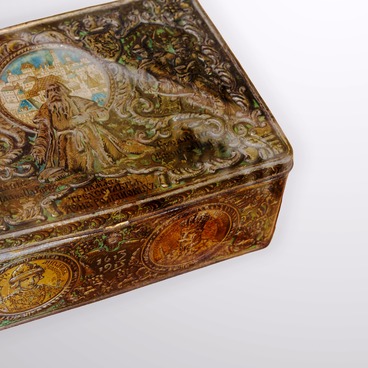Gustav Becker longcase clock is part of the interior design of the waiting room — one of the grand halls of the Livadia Palace Museum.
The clock has a traditional walnut case. It is tall, narrow, and decorated with carved floral patterns. It consists of three parts: the upper 55-cm-high section features a round 32-cm dial, the middle 110-cm-high section is a glass cabinet that houses the weight mechanism and protects the pendulum, and the lower section is a 60-cm-high pedestal that contacts the floor and ensures a stable vertical position of the entire structure. There are three metal tags on the back of the case which indicate the clock’s owners after the Great Patriotic War. Along with other evidence, it suggests that the clock was delivered to Livadia based on the list of property subject to purchase in Germany for special NKVD facilities in the USSR. The list was prepared in accordance with Decree of the USSR Council of Ministers No. 5020rs of April 15, 1946, in execution of Decree of the USSR Council of People’s Commissars No. 377-106ss of February 27, 1945 “On the Restoration of Livadia and Vorontsov Palaces and Their Use for Special Purposes by the USSR People’s Commissariat of Internal Affairs”.
The Cymbal-Gong clock with a long pendulum in the anchor escapement mechanism was produced by one of the largest clock exporters — the private German company Gustav Becker, founded in 1847. After the merger with Swiss clockmakers in the late 19th century, Gustav Becker’s clockmaking production was moved to Switzerland. In 1926, the company merged with Junghans, the renowned German manufacturer of large clocks. They continued to operate jointly until the end of the Second World War. With their high quality, design, and accuracy, Gustav Becker clocks won numerous awards at international exhibitions.
The clock has a traditional walnut case. It is tall, narrow, and decorated with carved floral patterns. It consists of three parts: the upper 55-cm-high section features a round 32-cm dial, the middle 110-cm-high section is a glass cabinet that houses the weight mechanism and protects the pendulum, and the lower section is a 60-cm-high pedestal that contacts the floor and ensures a stable vertical position of the entire structure. There are three metal tags on the back of the case which indicate the clock’s owners after the Great Patriotic War. Along with other evidence, it suggests that the clock was delivered to Livadia based on the list of property subject to purchase in Germany for special NKVD facilities in the USSR. The list was prepared in accordance with Decree of the USSR Council of Ministers No. 5020rs of April 15, 1946, in execution of Decree of the USSR Council of People’s Commissars No. 377-106ss of February 27, 1945 “On the Restoration of Livadia and Vorontsov Palaces and Their Use for Special Purposes by the USSR People’s Commissariat of Internal Affairs”.
The Cymbal-Gong clock with a long pendulum in the anchor escapement mechanism was produced by one of the largest clock exporters — the private German company Gustav Becker, founded in 1847. After the merger with Swiss clockmakers in the late 19th century, Gustav Becker’s clockmaking production was moved to Switzerland. In 1926, the company merged with Junghans, the renowned German manufacturer of large clocks. They continued to operate jointly until the end of the Second World War. With their high quality, design, and accuracy, Gustav Becker clocks won numerous awards at international exhibitions.


